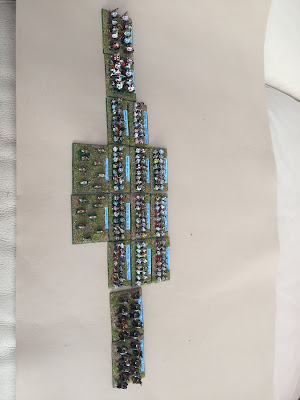 |
| Hmm can't seem to rotate this image! Strathclyde Welsh defying gravity it is then |
Two elements of Heavy Cavalry on the Right (top!) wing two elements of Medium Cavalry on the Left (bottom!). The Centre consists of eleven elements of Pedyt Medium Infantry spear and two elements of Light Infantry archers. There enough figures on the painting table for a further three MI elements and two Heavy Infantry Spear elements. The HI will be Anglo Saxon figures so they will look better dressed.
As I had to use proxy figures I used Baccus 6mm figures from the Gothic part of the Roman range. The spearmen make a really useful generic Dark Age warrior capable of being anything from early Franks through to lower grade Anglo-Saxon Fyrdmen and of course they can always be Visigoths or Ostrogoths. The Gothic Medium cavalry are equally useful; bare headed and unarmoured they can proxy for almost any early medieval unarmoured cavalry or mounted infantry. The Heavy cavalry work well for late Roman or early Byzantine heavy cavalry or as is the case here Sub Roman heavy cavalry. To be fair they might be a little too well equipped for Strathclyde in the 9th Century but they do resemble the mounted troops on the Pictish Aberlemno stone so that's good enough for me.
 |
Jolly Broom Man on his blog 1642andallthat has just had an interesting debate about Anglo-Saxon use of cavalry much of which derives from interpretations of the above stone. Well worth the time to go and read it. I’m in the ride to battle and dismount to fight camp, but it seems pretty obvious that the occasional mounted combat would have occurred either during pursuits or if caught without time to dismount. I don’t think that they deliberately intended to fight as cavalry or had experience as cavalry. I consider that at best they were mounted infantry. Certainly at Hereford in the early 11th century they came off second best when fighting against Welsh raiders from horse back.
As no one except Irregular do much in 6mm for the fringe nations of the Britain in the Viking Age ( and they only add two castings to the choices - Pictish spearmen and Scots Irish swordsmen) so for now it will have to be other figures acting as proxies. Fortunately conversion by paint brush is quick and easy.
Interesting period in our island's history. Plenty of allies and potential opponents for your Strathclyde Welsh.
ReplyDelete